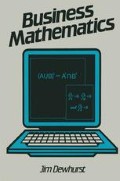Abstract
We have already used equations on a number of occasions, and throughout this book we shall continue to use them. Equations frequently summarise important facts. Thus the fact that the simple interest (I) at an interest rate (r) on a principal (P) is the rate multiplied by the principal can be summarized as I = rP. Equations can also be descriptive and useful for management decisions. In Chapter 3 we saw how the I = rP equation can be helpful in capital investment appraisal decisions. Equations can provide models either at macroeconomic level — for instance, the input output model for the economy (Chapter 5) — or at the microeconomic level. One example of the latter is that for a product produced by a firm, total costs are a + bx, where a are the fixed costs, b the variable costs per unit and x the number of units produced (provided that certain basic assumptions and conditions are met). If we call total costs y, these costs are then given by the equation y = a + bx.
Preview
Unable to display preview. Download preview PDF.
Copyright information
© 1988 Jim Dewhurst
About this chapter
Cite this chapter
Dewhurst, J. (1988). Linear and Higher-power Equations. In: Business Mathematics. Palgrave, London. https://doi.org/10.1007/978-1-349-19038-6_7
Download citation
DOI: https://doi.org/10.1007/978-1-349-19038-6_7
Publisher Name: Palgrave, London
Print ISBN: 978-0-333-38410-7
Online ISBN: 978-1-349-19038-6
eBook Packages: Palgrave Business & Management CollectionBusiness and Management (R0)

